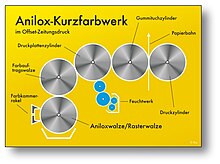Short inking unit
A short inking (engl .: short inking system) is a simply built inking system , which can do with less rolling and thus the printing ink transfers rapidly to the substrate.
Short inking units are used for low-viscosity (thin-bodied) inks; these inks cannot be transported over several rollers, a short path is necessary. The advantages of a short inking unit are fast, ink zone-free ink control and continuous ink supply.
Short inking units used in the printing industry in flexo printing , in high-pressure , in the web offset printing , in waterless offset printing and in coating.
In web offset newspaper printing, which does not require high inking quality , so-called ink zone - free short inking units are used. Compared to conventional offset inking units, the dampening unit is much smaller and fewer distributor rollers, including the associated ductor and master rollers, are required. Three construction methods have proven themselves in practice:
- with anilox roll (gravure roll), or particularly engraved metering roller with patterned squeegee
- with squeegee roller and / or squeegee
- with squeegee
literature
- DFTA, German-speaking flexographic printing specialist group e. V .; KH Meyer (ed.): Technique of flexographic printing. 5th expanded edition. Rek & Thomas Medien, St. Gallen 2006, ISBN 3-905330-17-2 .
- Kaj Johansson, Peter Lundberg, Robert Ryberg: Print production well done! 3rd expanded edition. Verlag Hermann Schmidt, Mainz 2008, ISBN 978-3-87439-731-5 .
- Helmut Kipphan: Handbook of the print media. Springer Verlag, Berlin et al. 2000, ISBN 3-540-66941-8 .
- Helmut Teschner: Print & Media Technology. 11th edition. Fachschriften Verlag, Fellbach 2003, ISBN 3-931436-88-8 .

